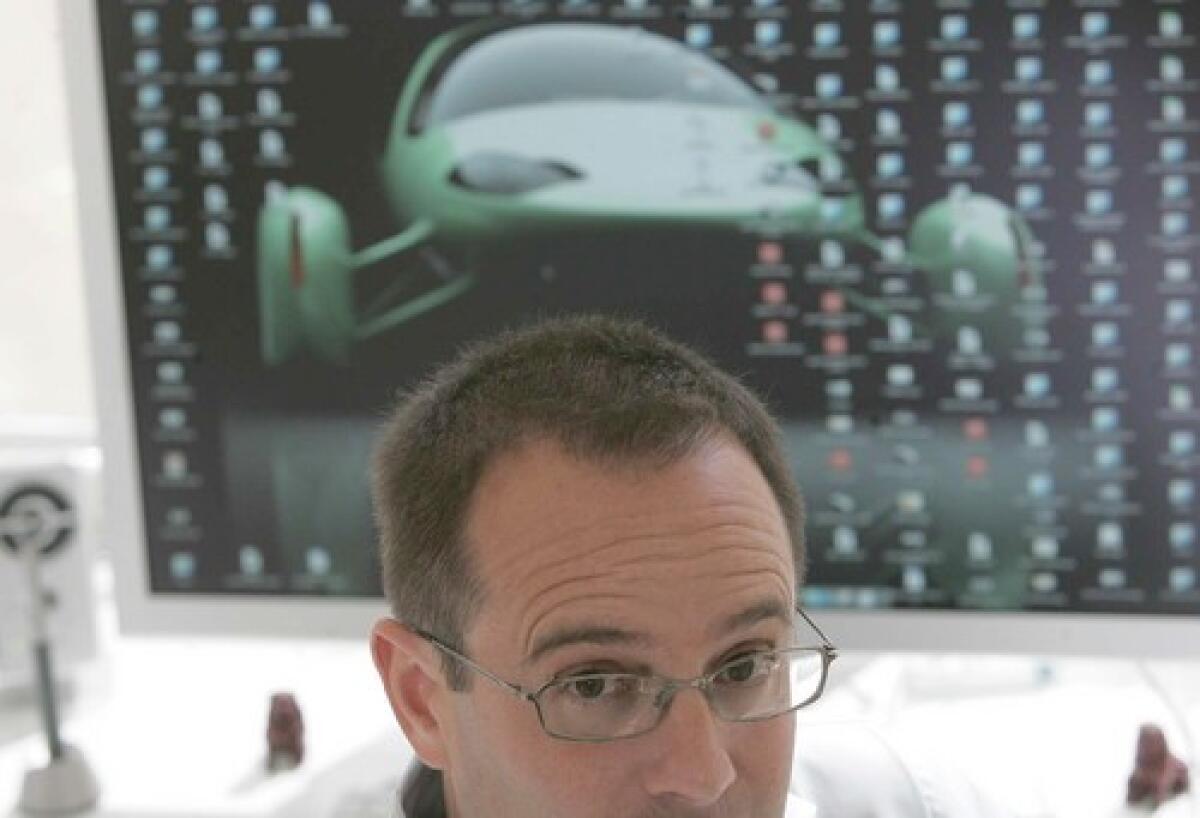Muscle-car designer makes U-turn

- Share via
For the son of a General Motors designer -- born and raised in Detroit in the final years of the “big, bigger and biggest” age of American cars -- creating a vehicle that doesn’t even have a combustion engine would seem an unlikely fate.
But in an era of nearly $4 gas, Jason Hill figured he had to do things a new way.
That’s why his cars are different. They’re sleeker. They’re more slippery. They weigh less and use recycled materials. In a word, they’re greener. And they don’t look like anything else on the road.
“I decided I want to be part of the solution,” said Hill, who turned to green design after more than a dozen years as a designer for Daimler and Porsche, working on the kind of sexy, muscle-car projects that most car freaks only dream of. “Anybody can build a hot rod. Do we really need another 200-mph sports car?”
As president and founder of the Long Beach-based firm Eleven, Hill holds the pole position of environmentally conscious vehicle design. Among his recent projects: the futuristic-looking Aptera, a three-wheeled, all-electric car that can go 120 miles on a charge, and a yacht with a solar-panel roof supplying juice to its electric motors.
Meanwhile, as an instructor at the Art Center College of Design in Pasadena, his alma mater, the 41-year-old Hill is training a new generation of designers to think differently about vehicles while maintaining a balance of form and function.
“He’s a big inspiration among young designers,” said Eric Noble, president of Car Lab, an automotive consulting firm in Orange. “He’s worked for carmakers. He’s gone his own road. And he’s not considered a sellout.”
The Aptera would seem to demonstrate that. Hill was assigned by the Carlsbad, Calif., start-up in 2006 to design a car that could cut down on wind resistance yet still be attractive.
“When I hired Jason, I said, ‘You will have carte blanche. You can do anything you want to do to this vehicle as long as you don’t increase drag,’ ” said Steve Fambro, Aptera’s founder and chief executive.
Less than a year later, Hill delivered. With its low, three-wheeled stance and a shape akin to a raindrop, the Aptera prototype is five times more slippery in the wind than a Toyota Prius and 25 times more than a Hummer, Fambro said. At 55 mph, the Aptera has less drag than a 10-speed bike.
Hill incorporated carpet made from recycled soda bottles and seat coverings made of 100% post-industrial and post-consumer material.
“He did an absolutely exquisite job,” said Fambro, who is having Hill put finishing touches on the $30,000 production model, due on roads by the end of this year.
Hill graduated from the Art Center in 1990 and landed a job at Daimler’s Mercedes design studio in Irvine. He stayed four years and worked on various projects, including the Micro concept car.
Planned to comply with California emissions regulations, the electric Micro was an innovative two-seat design for a city car. Though it never went into production, it served as the inspiration for the Smart ForTwo, the spunky economy car that went on sale in the U.S. this year after success in Europe and Asia.
In 1997, Hill moved to Samsung Motors. The South Korean company was looking to produce cars for export and brought on Hill as a senior designer. In the face of the Asian economic crisis, however, Samsung abandoned those plans, and Porsche bought out the design studio.
At Porsche, Hill led design of the Carrera GT concept, a blindingly fast super-car that looks like a “Star Wars” starfighter. It became a $450,000 production model that goes from 0 to 60 in under four seconds. But even in that most muscle-bound of muscle cars, Hill’s green tendencies shone through: The Carrera GT’s body panels were made of low-weight carbon fiber.
In 2003, he set out on his own, naming his firm Eleven after his birth month (November) and introducing a line of windscreens for Italian Vespa and Piaggio scooters. Today, he makes eight models and wholesales them for $50 to $100 apiece, selling as many as 5,000 a year.
Still, three-quarters of his business is vehicle design. Beyond the Aptera, he worked on the electric T3 Motion, a standing-up vehicle reminiscent of a Segway scooter, but with three wheels. It’s being used by police departments around the country, including in Los Angeles. He’s also working on a small electric boat.
Hill’s reputation as one of the few vehicle designers versed in green design has made him a hot property.
“I can really select customers based on their understanding of design and commitment to environmental issues,” Hill said.
That allows him to work on projects that enter uncharted design territory. Aerodynamics and innovative materials are extremely important to his design ethic. “Through design, you get desirability, and that’s how you get sustainability.”
But Hill hasn’t completely shaken his Motor City roots. He moonlights designing massively overpowered street machines with oversize tires, heavy steel construction, dropped suspensions and four-barrel carburetors.
Fear not, tree-huggers. The automaker is Mattel Inc. and the cars are Hot Wheels.
More to Read
Inside the business of entertainment
The Wide Shot brings you news, analysis and insights on everything from streaming wars to production — and what it all means for the future.
You may occasionally receive promotional content from the Los Angeles Times.










